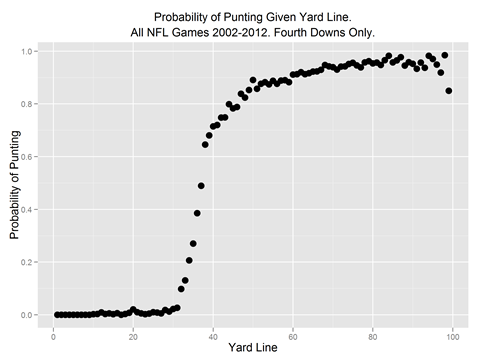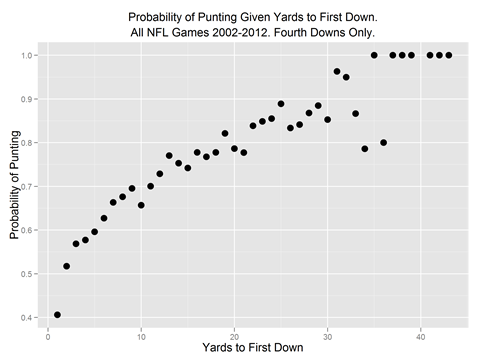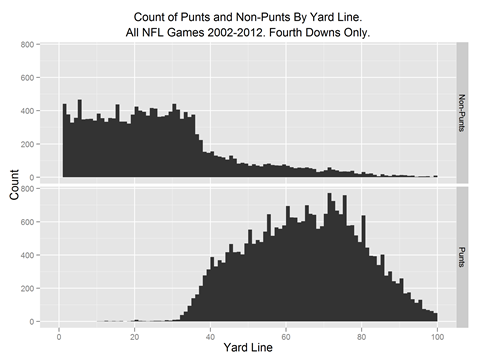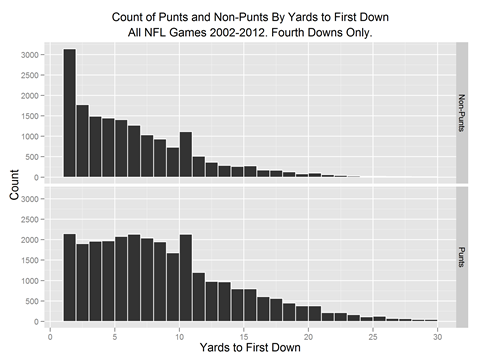Every NFL punt since 2002
ANALYSIS OF THE PUNTING DECISION BASED ON 11 YEARS OF PLAY-BY-PLAY DATA
The site reddit told us about data on every single NFL (U.S. National Football League) play since 2002. We read it in and did an analysis of punting. The results are beautiful.
North Americans metaphorically say they’re “going to punt” and people not familiar with American and Canadian Football can be unclear about what they mean. In the UK, “punt” means many things (such as pushing a boat with a stick or visiting a prostitute), but not the North American metaphorical sense.
Loosely put, to punt means to play it safe by not trying something risky that could leave you worse off. In football, it’s kicking the ball into a better field position instead of staying where you are and fighting because if you stay and fight you might lose and your opponent will have you in a bad field position. You punt when your back is to the wall, on your last “down” or opportunity to do something before the opponent automatically gets the ball. Higher risk alternatives to punting are passing or running with the ball. When close to the opponent’s goal, an alternative is trying to kick a field goal. [I realize that’s a bad description but maybe we can crowdsource a better one].
We made some graphs of the punting decision and found some beauty in these strategic behavior data.
Thanks to the reddit post and Advanced NFL Stats, as well as to the open source R language and Hadley Wickham‘s ggplot2.






I wonder whether the entomology of “going to punt” is actually the reverse of what you describe. i.e. The phrase has come to take this metaphorical meaning in common North American use because of the strategic way this kick is used in American football? Elsewhere in both forms of rugby, Aussie rules football, and, I think, Gaelic football, punt is specifically use to describe the sort of kick where the ball is dropped from the hands on to the kicking foot. This distinguishes the kick from a kick of a standing ball from the ground, and a dropped kick on the half volley. So in each of these codes of football “punt” refers to the specific style of kick used in North America when the team elects to punt.
Interestingly in rugby the punt kick is used with very similar tactical reasons – when the team has the ball but in a poor position on the field.
January 10, 2013 @ 8:59 am
Ian – Sorry to be unclear. We agree. I think the metaphorical usage comes from the use in the sport.
January 10, 2013 @ 2:02 pm
Some readers may also be interested in an analysis that suggests that teams punt far too much, relative to the optimum. The authors, economists, employ dynamic programming to derive optimal punting rules, and show that observed punting behavior is characterized by an exceedingly high degree of risk aversion.
D. Romer, “Do firms maximize? Evidence from professional football”, Journal of Political Economy, 114 (2006), pp. 340–365. http://www.journals.uchicago.edu/doi/abs/10.1086/501171
January 10, 2013 @ 9:07 am
I think there has to be some flaws in the data. Several points were surprising and unintuitive, but I refuse to believe that any coach in history has ever once punted from inside the opposing team’s 20.
January 10, 2013 @ 9:32 am
Be nice to include factors for game clock and score. You’ll probably find that most of those “dont’ punt” when deep in one’s own territory , and most “don’t punt” when more than 5 yards to go, occur late in the game. The offense needs to score, and has nothing to lose (other than the point spread, which is another story 🙂 ) by doing whatever they can to keep the ball.
@Kibbles: once your placekicker is out with an injury, it may well make sense to try to dead-drop a punt at the 5-yard line.
January 10, 2013 @ 1:12 pm
I think the X-axis on the first graph should read “Yards to goal line” in order to make sense. As written it implies (at least to me) that the odds of punting are ~100% when you’re within inches of the opposing team’s end-zone. Despite not being a sports nut I think I would have noticed that behavior.
January 10, 2013 @ 4:36 pm
Byron – See the advancednflstats link above in which yard line 98 is 98 yards to the goal line. The same point on the field becomes the yard line 2 when possession changes. Note the numbers written on the field are not yard lines in this sense because they go from 10 to 50 and back to 10, i.e., they never exceed 50.
January 11, 2013 @ 11:27 am
If you have all the plays, then it would be very interesting to compute the probability of retaining the ball under the different conditions. Probability of retention is low when punting (but not zero–receiver might fumble). The Romer data (paper cited above) is fairly old now so a new analysis of 4-th down success versus punting might be in order.
January 10, 2018 @ 12:12 am